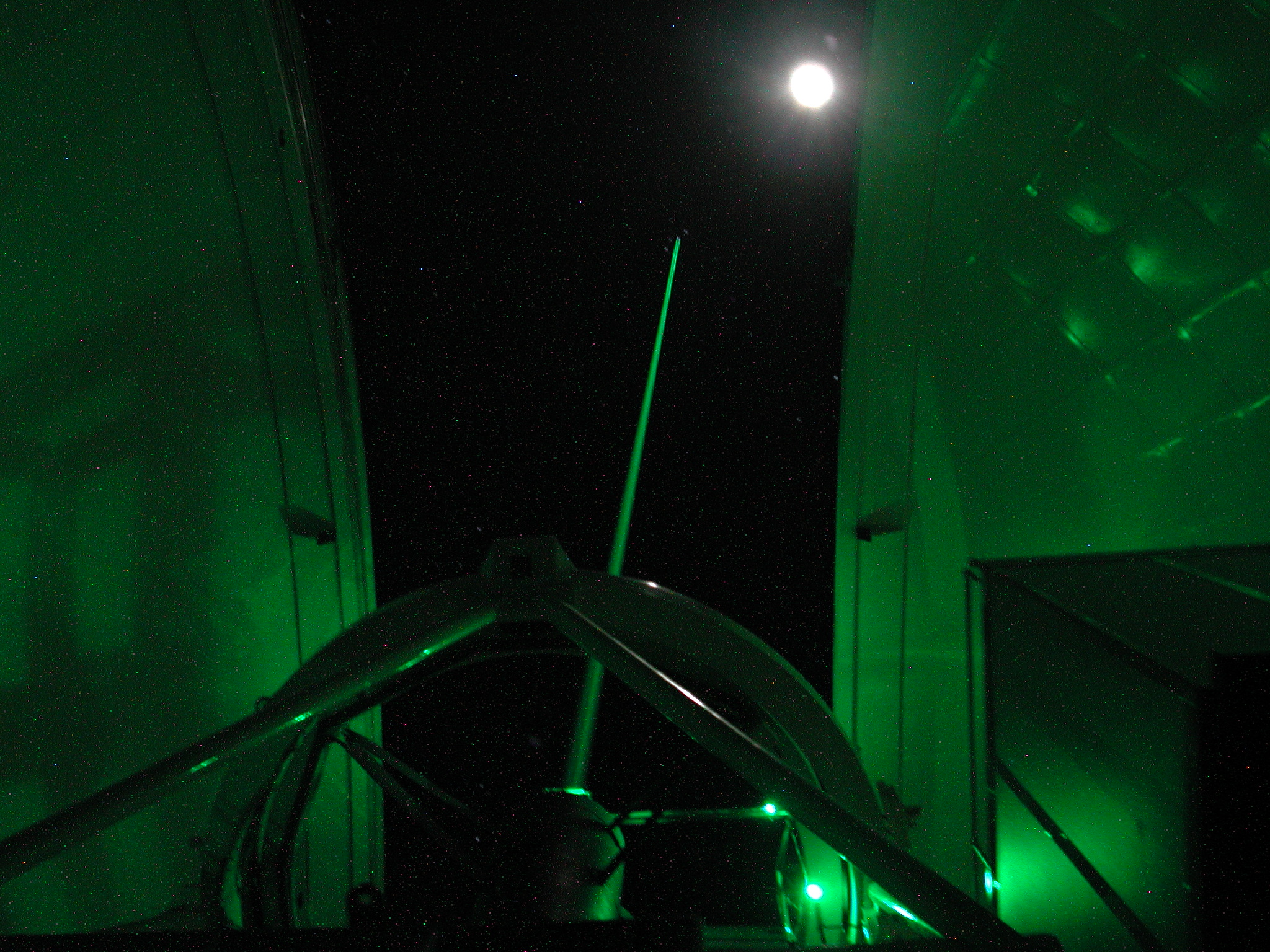GLAS
Grond-laag Laser Adaptieve optiek Systeem
Ground-layer Laser Adaptive optics System
A Rayleigh laser beacon for NAOMI
In January 2004 the Nederlandse Organisatie voor Wetenschappelijk
Onderzoek (NWO) announced its full support for the proposed development
of a laser beacon for the NAOMI Adaptive Optics system on the 4.2-m
William Herschel Telescope. Such a laser guide star system will amplify
the fraction of sky available to adaptive optics observations at visible
and infrared wavelengths from a few percent to nearly 100%. In terms of
astronomical research, this translates into radical progress as it opens
up high spatial resolution observations from the ground to nearly all
types of science targets. In combination with the existing and planned
instrumentation, the WHT will offer a highly competitive facility to the
astronomical community, exploiting a window of opportunity before similar
capability will exist on 8-m class telescopes.

Picture taken of a laser experiment at the WHT
conducted by the Astronomical Instrumentation Group of
Durham University.
Astronomical and Strategic Motivation
Adaptive optics (AO) techniques allow ground-based observers to obtain
spatial resolutions better than a tenth of an arcsecond by correcting
the image blurring introduced by the Earth's atmosphere. Hence the
resulting image sharpness not only carries the advantage of distinguishing
finer structure and avoiding source confusion in dense fields, but also
allows observations to reach significantly fainter, as the sky background
component reduces with the square of the angular resolution. For these
reasons, AO instrumentation is being planned for nearly all large telescopes,
and is at the heart of the future generation of extremely large telescopes.
At the 4.2-m William Herschel Telescope (WHT), AO recently came to fruition
with the commissioning of the common-user AO system, NAOMI, and an aggressive
instrument development programme. A main practical limitation for AO is the
availability of bright guide stars to measure the wavefront distortions,
which has caused AO in general to produce fewer science results than one
might have expected from its potential. By using an artificial laser guide
star this limitation is largely taken away, thus opening up AO to virtually
all areas of observational astronomy and to virtually all positions in the sky.
In particular, it opens up the possibility of observing faint and extended
sources, and will enable observations of large samples, unbiased by the
fortuitous presence of nearby bright stars. With a laser guide star facility,
a 4-m class telescope situated on a good observing site like La Palma is
highly competitive for AO exploitation next to the larger telescopes.
Scientific exploitation of AO encompasses all fields where achieving high
spatial resolution and/or sensitivity is needed to progress. The laser
guide star system for the WHT will take many areas of research from the
current situation where single objects can be studied, which happen to be
near a bright natural guide star, to a situation where all objects of
interest can be studied under the same conditions, regardless of their
position in the sky. This implies progress from case studies, to studies
of well-defined samples of objects. Examples are the search for brown
dwarfs and disks around solar type stars in obscured star formation regions,
super massive black holes, dynamics of nearby galaxy cores, circumnuclear
starbursts & AGN, gravitational lenses, and physical properties of moderately
high redshift galaxies.
System description
The Rayleigh laser system is designed to work in conjunction with existing
AO equipment and ancillary instrumentation and infrastructure. A 25W pulsed
laser will be projected to 15km altitude from a launch telescope mounted
behind the secondary mirror. The somewhat low altitude implies that turbulence
nearer the ground is best illuminated, and hence this is usually referred to
as ground-layer adaptive optics.
The Rayleigh back-scattered light will be detected by a new wavefront sensor
system to measure the wavefront shape from the laser guide star, and provide
corrections to the existing deformable mirror of the AO system. A Pockels cell
range-gate system that is synchronized with the laser pulses will set height
and duration of the laser return beam.
The existing wavefront sensor system will be dedicated to tip-tilt correction
measurements using a nearby natural guide star. A natural guide star will
still be required in conjunction with a laser beacon, because image displacement
due to atmospheric turbulence is cancelled as the laser light traverses the same
turbulence twice. The natural guide star can be much fainter than those required
for normal adaptive optics operation, and hence a much larger sky coverage is
achieved.
Scientific invitation
The laser development will open up a new exciting area of astronomical
exploitation for the William Herschel Telescope. There is much work ahead,
and much to learn on how to optimally use the future new facility. If you
are excited about the prospects as we are, and interested in working with
us to define detailed scientific plans, contact René Rutten at rgmr@ing.iac.es

